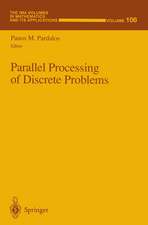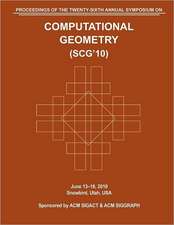Introduction to Parallel Programming
Autor Subodh Kumaren Limba Engleză Paperback – 4 ian 2023
Preț: 331.64 lei
Preț vechi: 414.55 lei
-20% Nou
Puncte Express: 497
Preț estimativ în valută:
63.46€ • 67.86$ • 52.91£
63.46€ • 67.86$ • 52.91£
Carte disponibilă
Livrare economică 27 martie-10 aprilie
Livrare express 12-18 martie pentru 30.64 lei
Preluare comenzi: 021 569.72.76
Specificații
ISBN-13: 9781009069533
ISBN-10: 1009069535
Pagini: 350
Dimensiuni: 185 x 241 x 15 mm
Greutate: 0.5 kg
Ediția:Nouă
Editura: Cambridge University Press
Colecția Cambridge University Press
Locul publicării:Cambridge, United Kingdom
ISBN-10: 1009069535
Pagini: 350
Dimensiuni: 185 x 241 x 15 mm
Greutate: 0.5 kg
Ediția:Nouă
Editura: Cambridge University Press
Colecția Cambridge University Press
Locul publicării:Cambridge, United Kingdom
Cuprins
List of Figures; Introduction; Concurrency and Parallelism; Why Study Parallel Programming; What is in this Book; 1. An Introduction to Parallel Computer Architecture; 1.1 Parallel Organization; SISD: Single Instruction, Single Data; SIMD: Single Instruction, Multiple Data; MIMD: Multiple Instruction, Multiple Data; MISD: Multiple Instruction, Single Data; 1.2 System Architecture; 1.3 CPU Architecture; 1.4 Memory and Cache; 1.5 GPU Architecture; 1.6 Interconnect Architecture; Routing; Links; Types and Quality of Networks; Torus Network; Hypercube Network; Cross-Bar Network; Shuffle-Exchange Network; Clos Network; Tree Network; Network Comparison; 1.7 Summary; 2. Parallel Programming Models; 2.1 Distributed-Memory Programming Model; 2.2 Shared-Memory Programming Model; 2.3 Task Graph Model; 2.4 Variants of Task Parallelism; 2.5 Summary; 3. Parallel Performance Analysis; 3.1 Simple Parallel Model; 3.2 Bulk-Synchronous Parallel Model; BSP Computation Time; BSP Example; 3.3 PRAM Model; PRAM Computation Time; PRAM Example; 3.4 Parallel Performance Evaluation; Latency and Throughput; Speed-up; Cost; Efficiency; Scalability; Iso-efficiency; 3.5 Parallel Work; Brent's Work-Time Scheduling Principle; 3.6 Amdahl's Law; 3.7 Gustafson's Law; 3.8 Karp–Flatt Metric; 3.9 Summary; 4. Synchronization and Communication Primitives; 4.1 Threads and Processes; 4.2 Race Condition and Consistency of State; Sequential Consistency; Causal Consistency; FIFO and Processor Consistency; Weak Consistency; Linearizability; 4.3 Synchronization; Synchronization Condition; Protocol Control; Progress; Synchronization Hazards; 4.4 Mutual Exclusion; Lock; Peterson's Algorithm; Bakery Algorithm; Compare and Swap; Transactional Memory; Barrier and Consensus; 4.5 Communication; Point-to-Point Communication; RPC; Collective Communication; 4.6 Summary; 5. Parallel Program Design; 5.1 Design Steps; Granularity; Communication; Synchronization; Load Balance; 5.2 Task Decomposition; Domain Decomposition; Functional Decomposition; Task Graph Metrics; 5.3 Task Execution; Preliminary Task Mapping; Task Scheduling Framework; Centralized Push Scheduling Strategy; Distributed Push Scheduling; Pull Scheduling; 5.4 Input/Output; 5.5 Debugging and Profiling; 5.6 Summary; 6. Middleware: The Practice of Parallel Programming; 6.1 OpenMP; Preliminaries; OpenMP Thread Creation; OpenMP Memory Model; OpenMP Reduction; OpenMP Synchronization; Sharing a Loop's Work; Other Work-Sharing Pragmas; SIMD Pragma; Tasks; 6.2 MPI; MPI Send and Receive; Message-Passing Synchronization; MPI Data Types; MPI Collective Communication; MPI Barrier; MPI Reduction; One-Sided Communication; MPI File IO; MPI Groups and Communicators; MPI Dynamic Parallelism; MPI Process Topology; 6.3 Chapel; Partitioned Global Address Space; Chapel Tasks; Chapel Variable Scope; 6.4 Map-Reduce; Parallel Implementation; Hadoop; 6.5 GPU Programming; OpenMP GPU Off-Load; Data and Function on Device; Thread Blocks in OpenMP; CUDA; CUDA Programming Model; CPU–GPU Memory Transfer; Concurrent Kernels; CUDA Synchronization; CUDA Shared Memory; CUDA Parallel Memory Access; False Sharing; 6.6 Summary; 7. Parallel Algorithms and Techniques; 7.1 Divide and Conquer: Prefix-Sum; Parallel Prefix-Sum: Method 1; Parallel Prefix-Sum: Method 2; Parallel Prefix-Sum: Method 3; 7.2 Divide and Conquer: Merge Two Sorted Lists; Parallel Merge: Method 1; Parallel Merge: Method 2; Parallel Merge: Method 3; Parallel Merge: Method 4; 7.3 Accelerated Cascading: Find Minima; 7.4 Recursive Doubling: List Ranking; 7.5 Recursive Doubling: Euler Tour; 7.6 Recursive Doubling: Connected Components; 7.7 Pipelining: Merge-Sort; Basic Merge-Sort; Pipelined Merges; 4-Cover Property Analysis; Merge Operation per Tick; 7.8 Application of Prefix-Sum: Radix-Sort; 7.9 Exploiting Parallelism: Quick-Sort; 7.10 Fixing Processor Count: Sample-Sort; 7.11 Exploiting Pa
Notă biografică
Descriere
This book introduces students to the full gamut of different parallel programming styles and their relationship to hardware architecture.



















